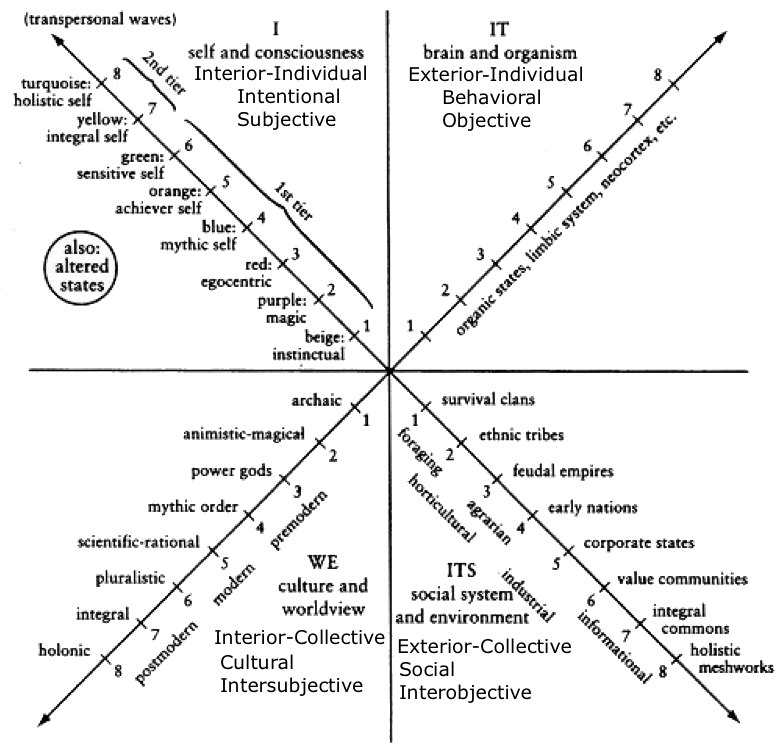 mental
mental
 Consciousness Models
Consciousness Models
 Integral Theory
Integral Theory
In A Theory of Everything, Wilber (2000) integrates the work of the theorists, Graves and Gebser, as well as that of Piaget, on various axes of his AQAL (all-quadrant, all-level) model.
By way of example, one can crudely categorize the perspectives taken on people and their behavior in different schools of thought:
- Individual interior accounts (upper-left quadrant) include Freudian psychoanalysis, which interprets people's interior experiences and focuses on "I".
It uses the Spiral Dynamics (Graves) levels.
Representative Thinkers: Freud, Jung, Piaget, Plotinus, Aurobindo, Gautama Buddah - Interior plural accounts (lower-left) include Gadamer's philosophical hermeneutics which seeks to interpret the collective consciousness of a society, or plurality of people and focuses on "We"
One interesting article related to this quadrant was "Facing Religion, From Anthropology", by Michael Lambek
Representative Thinkers: Thomas Kuhn, Wilhelm Dilthey, Jean Gebser, Max Weber, Hans-Georg Gadamer - Exterior individual accounts (upper-right) include B. F. Skinner's behaviorism, which limits itself to the observation of the behavior of organisms and treats the internal experience, decision making or volition of the subject as a black box, and which with the fourth perspective emphasizes the subject as a specimen to examine, or "It".
Representative Thinkers: BF Skinner Richard Dawkins, John Locke, Empiricism, Behaviourism, Physics, Biology, Neurology - Exterior plural accounts (lower-right) include Marxist economic theory which focuses upon the behavior of a society (ie a plurality of people) as functional entities seen from outside.
Representative Thinkers: Systems Theory, Talcott Parsons, Auguste Comte, Karl Marx, Ecological,
Progressive development in all quadrants can be pictured as a series of ever-larger concentric circles having the origin as their common center.
Wilber's conceptualisation of the I, We and It (or Its), can be linked to Plato's interpretation of "value" in terms of: the True (propositional truth referring to an objective state of affairs (It)); the Good (the cultural justices and appropriateness (We)); and the Beautiful (the individual aesthetic dimension - (I)). It can also be linked to the three "jewels" of Buddhism, namely: Buddha as the ultimate I; Dharma as the ultimate It and Sangha as the ultimate We (Wilber, 2000). From a Christian perspective it probably reflects: hope (I), love (We) and faith (It).
Links:
Amazon.com: A Theory of Everything: An Integral Vision for Business, Politics, Science and Spirituality, 2000, by Ken Wilber
Another version of the chart from Leading a justice system | What is Global Citizenship?
Integral theory - Wikipedia
Consciousness Models in Action: Comparisons
Review of A THEORY OF EVERYTHING
Ken Wilber's AQAL Metatheory: An Overview, Paul Helfrich
Social Aspects of the integral vision, 1st World Congress of NLP
28 May 2006, Berlin
Leading a justice system | What is Global Citizenship?
